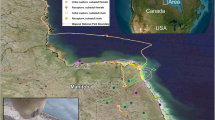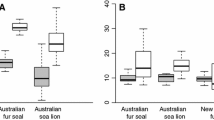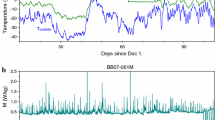Abstract
Climate change is expected to increase the frequency and duration of long-distance swims by polar bears (Ursus maritimus). The energetic costs of such swims are assumed to be large, however, no estimates of metabolic costs of swimming for polar bears are available. Here, I use data on internal body temperature and external ambient temperature for two swimming polar bears, combined with mathematical modeling of heat production and of heat conduction to the surrounding water, to estimate the metabolic rate of swimming. Using this metabolic rate, I then examine the relative heat production and heat loss for bears of a range of sizes and body conditions. I calculated overall mean metabolic rate for a swimming bear to be 2.75 ml O2 g−1 h−1, which is generally higher than metabolic rates previously reported for walking polar bears. When compared at the same movement rate, the cost of transport for swimming was estimated to be approximately 5× that of walking. I further show that for small bears (less than approx. 145 cm body length or 90 kg) and bears in poor body condition, heat loss while swimming in cold Arctic waters should exceed heat production, and long swims should therefore not be thermodynamically sustainable. These results support previous claims that increasing frequency and duration of long-distance swims in polar bears is energetically stressful. Energetic and thermodynamic costs of long swims may be further exacerbated by recent declines in body condition that have been documented due to climate warming.



Similar content being viewed by others
References
Aars J, Plumb A (2010) Polar bear cubs may reduce chilling from icy water by sitting on mother’s back. Polar Biol 33:557–559. doi:10.1007/s00300-009-0721-3
Best RC (1976) Ecological energetics of the polar bear (Ursus maritimus Phipps 1774). Thesis. University of Guelph, Guelph, Ontario
Best RC (1982) Thermoregulation in resting and active polar bears. J Comp Phys 146:63–73. doi:10.1007/BF00688718
Best RC, Ronald K, Øritsland NA (1981) Physiological indices of activity and metabolism in the polar bear. Comp Biochem Phys A 69:177–185. doi:10.1016/0300-9629(81)90279-6
Blix AS, Lentfer JW (1979) Modes of thermal protection in polar bear cubs—at birth and on emergence from the den. Am J Physiol Regul I 236:R67–R74
Cattet MRL, Caulkett NA, Obbard ME, Stenhouse GB (2002) A body-condition index for ursids. Can J Zool 80:1156–1161. doi:10.1139/z02-103
Cherry SG, Derocher AE, Lunn NJ (2016) Habitat-mediated timing of migration in polar bears: an individual perspective. Ecol Evol 6:5032–5042. doi:10.1002/ece3.2233
Crawford JA, Quakenbush LT, Citta JJ (2015) A comparison of ringed and bearded seal diet, condition and productivity between historical (1975–1984) and recent (2003–2012) periods in the Alaskan Bering and Chukchi seas. Prog Oceanogr 136:133–150. doi:10.1016/j.pocean.2015.05.011
de la Guardia LC, Myers PG, Derocher AE, Lunn NJ, van Scheltinga ADT (2017) Sea ice cycle in western Hudson Bay, Canada, from a polar bear perspective. Mar Ecol Progr Ser 564:225–233. doi:10.3354/meps119640.3354/meps11964
Derocher AE, Wiig Ø (2002) Postnatal growth in body length and mass of polar bears (Ursus maritimus) at Svalbard. J Zool 256:343–349. doi:10.1017/S0952836902000377
Derocher AE, Lunn NJ, Stirling I (2004) Polar bears in a warming climate. Integr Comp Biol 44:163–176. doi:10.1093/icb/44.2.163
Derocher AE, Andersen M, Wiig Ø, Aars J, Hansen E, Biuw M (2011) Sea ice and polar bear den ecology at Hopen Island, Svalbard. Mar Ecol Progr Ser 441:273–279. doi:10.3354/meps09406
Durner GM, Douglas DC, Nielson RM, Amstrup SC, McDonald TL, Stirling I, Mauritzen M, Born EW, Wiig Ø, DeWeaver E, Serreze MC, Belikov SE, Holland MM, Maslanik J, Aars J, Bailey DA, Derocher AE (2009) Predicting 21st century polar bear habitat distribution from global climate models. Ecol Monogr 79:25–58. doi:10.1890/07-2089.1
Durner GM, Whiteman JP, Harlow HJ, Amstrup SC, Regehr EV, Ben-David M (2011) Consequences of long-distance swimming and travel over deep-water pack ice for a female polar bear during a year of extreme sea ice retreat. Polar Biol 34:975–984. doi:10.1007/s00300-010-0953-2
Elliott JM, Davison W (1975) Energy equivalents of oxygen consumption in animal energetics. Oecologia 19:195–201
Finkelstein EA, Zhen C, Nonnemaker J, Todd JE (2010) Impact of targeted beverage taxes on higher- and lower-income households. Arch Intern Med 170:2028–2034. doi:10.1001/archinternmed.2010.449
Fish FE, Baudinette RV (1999) Energetics of locomotion by the Australian water rat (Hydromys chrysogaster): a comparison of swimming and running in a semi-aquatic mammal. J Exp Biol 202:353–363
Freitas C, Kovacs KM, Andersen M, Aars J, Sandven S, Skern-Mauritzen M, Pavlova O, Lydersen C (2012) Importance of fast ice and glacier fronts for female polar bears and their cubs during spring in Svalbard, Norway. Mar Ecol Progr Ser 447:289–304. doi:10.3354/meps09516
Frey KE, Moore GWK, Cooper LW, Grebmeier JM (2015) Divergent patterns of recent sea ice cover across the Bering, Chukchi, and Beaufort seas of the Pacific Arctic Region. Prog Oceanogr 136:32–49. doi:10.1016/j.pocean.2015.05.009
Frisch J, Øritsland NA, Krog J (1974) Insulation of furs in water. Comp Biochem Phys A 47:403–410. doi:10.1016/0300-9629(74)90002-4
Gaston AJ, Gilchrist HG, Hipfner JM (2005) Climate change, ice conditions and reproduction in an Arctic nesting marine bird: Brunnich’s guillemot (Uria lomvia L.). J Anim Ecol 74:832–841. doi:10.1111/j.1365-2656.2005.00982.x
Gormenzano LJ, McWilliams SR, Iles DT, Rockwell RF (2016) Cost of locomotion in polar bears: when do the costs outweigh the benefits of chasing down terrestrial prey? Conserv Physiol. doi:10.1093/conphys/cow045
Hamilton CD, Lydersen C, Ims RA, Kovacs KM (2016) Costal habitat use by ringed seals Pusa hispida following a regional sea-ice collapse: importance of glacial refugia in a changing Arctic. Mar Ecol Progr Ser 545:261–277. doi:10.3354/meps11598
Hertel H (1966) Structure, form, movement. Reinhold, New York
Hurst RJ, Øritsland NA, Watts PD (1982) Body mass, temperature and cost of walking in polar bears. Acta Physiol Scand 115:391–395. doi:10.1111/j.1748-1716.1982.tb07096.x
IT’IS (2016) Fluid properties database V3.1 (13.10.2016). Foundation for Research on Information Technologies in Society. https://www.itis.ethz.ch/virtual-population/tissue-properties/database/heat-capacity/. Accessed 1 February 2017
Kvadsheim PH, Folkow LP, Blix AS (1994) A new device for measurement of the thermal conductivity of fur and blubber. J Therm Biol 19:135–431. doi:10.1016/0306-4565(94)90043-4
Lienhard JH, Lienhard JH (2017) A heat transfer textbook. Phlogiston Press, Cambridge
Lister AM (2014) Behavioural leads in evolution: evidence from the fossil record. Biol J Linn Soc 112:315–331. doi:10.1111/bij.12173
Liu S, Lorenzen ED, Furnagalli M, Li B, Harris K, Xiong Z, Zhou L, Korneliussen TS, Somel M, Babbitt C, Wray G, Li J, He W, Wang Z, Fu W, Xiang X, Morgan CC, Doherty A, O’Connell MJ, McInerney JO, Born EW, Dalén L, Dietz R, Orlando L, Sonne C, Zhang G, Nielsen R, Willerslev E, Wang J (2014) Population genomics reveal recent speciation and rapid evolutionary adaptation in polar bears. Cell 157:785–794. doi:10.1016/j.cell.2014.03.054
Liwanag HEM, Berta A, Costa DP, Budge SM, Williams TM (2012) Morphological and thermal properties of mammalian insulation: the evolutionary transition to blubber in pinnipeds. Biol J Linn Soc 107:774–787. doi:10.1111/j.1095-8312.2012.01992.x
McCall AG, Pilfold NW, Derocher AE, Lunn NJ (2016) Seasonal habitat selection by adult female polar bears in western Hudson Bay. Popul Ecol 58:407–419. doi:10.1007/s10144-016-0549-y
Molnár PK, Klanjscek T, Derocher AE, Obbard ME, Lewis MA (2009) A body composition model to estimate mammalian energy stores and metabolic rates from body mass and body length, with application to polar bears. J Exp Biol 212:2313–2323. doi:10.1242/jeb.026146
Molnár PK, Derocher AE, Klanjscek T, Lewis MA (2011) Predicting climate change impacts on polar bear litter size. Nat Commun 2:186. doi:10.1038/ncomms1183
Monnett C, Gleason JS (2006) Observations of mortality associated with extended open-water swimming by polar bears in the Alaskan Beaufort Sea. Polar Biol 29:681–687. doi:10.1007/s00300-005-0105-2
Obbard ME, Cattet MRL, Moody T, Walton LR, Potter D, Inglis J, Chenier C (2006) Temporal trends in the body condition of Southern Hudson Bay Polar Bears. Clim Change Res Inf Note 3:1–8
Obbard ME, Cattet MRL, Howe EJ, Middel KR, Newton EJ, Kolenosky GB, Abraham KF, Greenwood CJ (2016) Trends in body condition in polar bears (Ursus maritimus) from the Southern Hudson Bay subpopulation in relation to changes in sea ice. Arctic Sci 2:15–32. doi:10.1139/as-2015-0027
Ogita F, Tabata I (1993) Effect of hand paddle aids on oxygen uptake during arm-stroke-only swimming. Eur J Appl Physiol 66:489–493
Olson JW, Rode KD, Eggett D, Smith TS, Wilson RR, Durner GM, Fischbach A, Atwood TC, Douglas DC (2017) Collar temperature sensor data reveal long-term patterns in southern Beaufort Sea polar bear den distribution on pack ice and land. Mar Ecol Progr Ser 4:211–224. doi:10.3354/meps12000
Øritsland NA (1969) Deep body temperatures of swimming and walking polar bear cubs. J Mammal 50:380–382. doi:10.2307/1378372
Øritsland NA (1970) Temperature regulation of the polar bear (Thalarctos maritimus). Comp Biochem Physiol 37:225–233. doi:10.1016/0010-406X(70)90547-5
Pagano AM, Durner GM, Amstrup SC, Simac KS, York GS (2012) Long-distance swimming by polar bears (Ursus maritimus) of the southern Beaufort during years of extensive open water. Can J Zool 90:663–676. doi:10.1139/z2012-033
Parry DA (1949) The structure of whale blubber, and a discussion of its thermal properties. J Cell Sci 3:13–25
Pilfold NW, Derocher AE, Richardson E (2014) Influence of intraspecific competition on the distribution of a wide ranging, non territorial carnivore. Glob Ecol Biogeogr 23:425–435. doi:10.1111/geb.12112
Pilfold NW, Hedman D, Stirling I, Derocher AE, Lunn NJ, Richardson E (2016) Mass loss rates of fasting polar bears. Phys Biochem Zool 89:377–388. doi:10.1086/687988
Pilfold NW, McCall A, Derocher AE, Lunn NJ, Richardson E (2017) Migratory response of polar bears to sea ice loss: to swim or not to swim. Ecography 40:189–199. doi:10.1111/ecog.02109
Pond CM, Mattacks CA, Colby RH, Ramsay MA (1992) The anatomy, chemical composition, and metabolism of adipose tissue in wild polar bears (Ursus maritimus). Can J Zool 70:326–341. doi:10.1139/z92-049
Ponganis PJ, Van Dam RP, Levenson DH, Knower T, Ponganis KV, Marshall G (2003) Regional heterothermy and conservation of core temperature in emperor penguins diving under sea ice. Comp Biochem Phys A 135:477–487. doi:10.1016/S1095-6433(03)00133-8
Post E, Forchhammer MC, Bret-Harte MS, Callaghan TV, Christensen TR, Elberling B, Fox AD, Gilg O, Hik DS, Hoye TT, Ims RA, Jeppesen E, Klein DR, Madsen J, McGuire AD, Rysgaard S, Schindler DE, Stirling I, Tamstorf MP, Tyler NJC, van der Wal R, Welker J, Wookey PA, Schmidt NM, Aastrup P (2009) Ecological dynamics across the Arctic associated with recent climate change. Science 325:1355–1358. doi:10.1126/science.1173113
Ryg M, Lydersen C, Knutsen LØ, Bjørge A, Smith TG, Øritsland NA (1993) Scaling of insulation in seals and whales. J Zool 230:193–206. doi:10.1111/j.1469-7998.1993.tb02682.x
Scholander PF, Walters V, Hock R, Irving L (1950) Body insulation of some arctic and tropical mammals and birds. Biol Bull 99:225–236. doi:10.2307/1538740
Serreze MC, Barry RG (2005) The Arctic climate system. Cambridge University Press, New York
Serreze MC, Walsh JE, Chapin FSI III, Osterkamp T, Dyurgerov M, Romanovsky V, Oechel WC, Morison J, Zhang T, Barry RG (2000) Observational evidence of recent change in the northern high-latitude environment. Clim Change 46:159–207
Simmonds I, Burke C, Keay K (2008) Arctic climate change as manifest in cyclone behavior. J Clim 21:5777–5796. doi:10.1175/2008JCLI2366.1
Smith TA, Lin BH, Lee JY (2010) Taxing Caloric Sweetened Beverages: Potential Effects on Beverage Consumption, Calorie Intake, and Obesity. Economic Research Report #100. USDA, Washington, DC
Speakman JR, Król E, Johnson MS (2004) The functional significance of individual variation in basal metabolic rate. Phisiol Biochem Zool 77:900–915. doi:10.1086/427059
Stirling I (1974) Midsummer observations on the behavior of wild polar bears (Ursus maritimus). Can J Zool 52:1191–1198. doi:10.1139/z74-157
Stirling I, Derocher AE (1990) Factors affecting the evolution and behavioral ecology of the modern bears. Bears: Their Biology and Management, Vol. 8, A Selection of Papers from the Eighth International Conference on Bear Research and Management, Victoria, British Columbia, Canada, February 1989, pp. 189–204. doi: 10.2307/3872919
Stirling I, Derocher AE (2012) Effects of climate warming on polar bears: a review of the evidence. Glob Change Biol 18:2694–2706. doi:10.1111/j.1365-2486.2012.02753.x
Stirling I, Andriashek D, Calvert W (1993) Habitat preferences of polar bears in the western Canadian Arctic in late winter and spring. Polar Rec 29:13–24. doi:10.1017/S0032247400023172
Stroeve J, Holland MM, Meier W, Scambos T, Serreze M (2007) Arctic sea ice decline: faster than forcast. Geophys Res Lett 34:L09501. doi:10.1029/2007GL029703
Stroeve JC, Serreze MC, Holland MM, Kay JE, Malanik J, Barrett AP (2012) The Arctic’s rapidly shrinking sea ice cover: a research synthesis. Clim Change 110:1005–1027. doi:10.1007/s10584-011-0101-1
Thiemann GW, Iverson SJ, Stirling I (2006) Seasonal, sexual and anatomical variability in the adipose tissue of polar bears (Ursus maritimus). J Zool 269:65–76. doi:10.1111/j.1469-7998.2006.00084.x
Toussaint HM, Beek PJ (1992) Biomechanics of competitive front crawl swimming. Sports Med 13:8–24
Toussaint HM, de Groot G, Savelberg HHCM, Vervoorn K, Hollander AP, van Ingen Schenau GJ (1988) Active drag related to velocity in male and female swimmers. J Biomech 21:435–438. doi:10.1016/0021-9290(88)90149-2
Toussaint HM, Janssen T, Kluft M (1991) Effect of propelling surface size on the mechanics and energetics of front crawl swimming. J Biomech 24:205–211. doi:10.1016/0021-9290(91)90178-P
Turner J, Colwell SR, Marshall GJ, Lachlan-Cope TA, Carleton AM, Jones PD, Lagun V, Reid PA, Iagovkina S (2005) Antarctic climate change during the last 50 years. Int J Climatol 25:279–294. doi:10.1002/joc.1130
Videler JJ, Nolet BA (1990) Costs of swimming measured at optimum speed: scale effects, differences between swimming styles, taxonomic groups and submerged and surface swimming. Comp Biochem Phys A 97:91–99. doi:10.1016/0300-9629(90)90155-L
Whiteman JP, Harlow JH, Durner GM, Anderson-Sprecher R, Albeke SE, Regehr EV, Amstrup SC, Ben-David M (2015) Summer declines in activity and body temperature offer polar bears limited energy savings. Science 349:295–298. doi:10.1126/science.aaa8623
Williams TM (1983a) Locomotion in the North American mink, a semi-aquatic mammal I. Swimming energetics and body drag. J Exp Biol 103:155–168
Williams TM (1983b) Locomotion in the North American mink, a semi-aquatic mammal II. The effect of an elongate body on running energetics and gait patterns. J Exp Biol 105:283–295
Williams TM (1999) The evolution of cost efficient swimming in marine mammals: limits to energetic optimization. Phil Trans R Soc Lond B 354:193–201
Zamparo P, Lazzer S, Antoniazzi C, Cedolin S, Avon R, Lesa C (2008) The interplay between propelling efficiency, hydrodynamic position and energy cost of front crawl in 8 to 19-year-old swimmers. Eur J Appl Physiol 104:689. doi:10.1007/s00421-008-0822-7
Acknowledgements
I thank GM Durner, the University of Wyoming, Department of Zoology and Physiology, as well as the USGS Alaska Science Center for providing the data on bear 20741. Additionally, I thank JP Whiteman for data on bear 20414. Finally, I thank anonymous reviewers and editors for valuable comments that greatly improved the manuscript.
Author information
Authors and Affiliations
Corresponding author
Rights and permissions
About this article
Cite this article
Griffen, B.D. Modeling the metabolic costs of swimming in polar bears (Ursus maritimus). Polar Biol 41, 491–503 (2018). https://doi.org/10.1007/s00300-017-2209-x
Received:
Revised:
Accepted:
Published:
Issue Date:
DOI: https://doi.org/10.1007/s00300-017-2209-x




